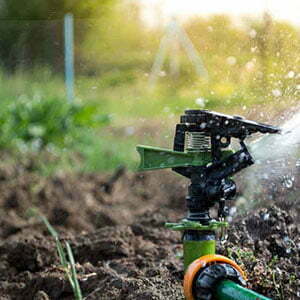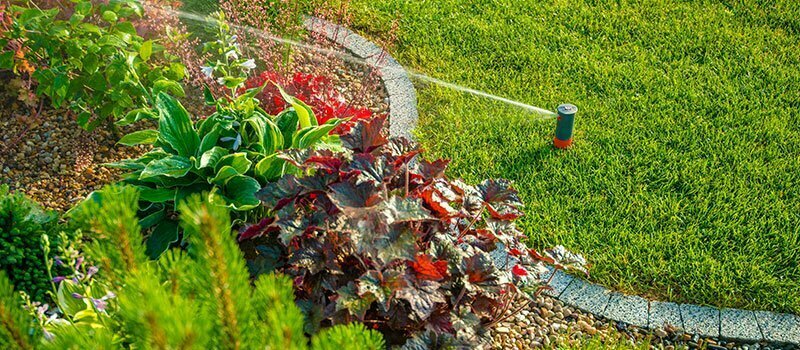The bright sun and warm climate in Phoenix area is perfectly suited for growing vegetables all year long. Watering them is the tricky part. Too little water means low yields. Too much means diseased and damaged plants. Proper irrigation is a fantastic solution. Whether you need a new system installed or garden bed sprinkler repair for your Gilbert, AZ landscaping, these tips will help you out.
Choosing Your System
- Drip Irrigation: Also known as soaker hoses, drip irrigation for vegetable gardens use thick hoses with emitter points placed along them at regular intervals. They deliver precise amounts of water to each plant. Because they’re close to the ground, they minimize evaporation. The system maximizes water efficiency while letting you fine-tune how much water any given row of plants will get. However, your plantings are limited to straight rows and even spacing.
- Sprinklers: Standard sprinklers are often the more inexpensive option. Garden bed sprinklers are smaller than your standard lawn sprinkler and have a limited range. Unlike lawn sprinklers, the heads are typically fixed and don’t rotate. Due to evaporation and blanket application, sprinklers are less water efficient. However, they allow you more freedom to change your bed layouts in the future.
 After Installation
After Installation
Monitoring your new system is essential for avoiding costly repairs. Check your lines regularly, act at the first sign of trouble and schedule routine maintenance and sprinkler repair from Gilbert, AZ irrigation specialists.
Check your emitters regularly for signs of mineral buildup. Clogged emitters don’t run efficiently and cause pressure changes that damage the system. Identifying the type of buildup and cleaning it yourself is complicated, so call in your installers to make sure it’s done right.
Check on your filter and follow any recommendations your installer gives you for cleaning it. As with emitters, clogged filters can cause pressure changes in the system that can lead to damage and alterations in water flow.
The water needs of your plants is likely to change from season to season, especially if you switch plantings. Remember to reprogram your scheduler or have your installer come back and do it for you.
Emitter and filter checks, schedule adjustment and other important checks are all part of seasonal maintenance plans available from your installer. The best way to keep your system in shape is to sign up for the plan. Problems can be addressed swiftly and save you from expensive repair bills.
Tips for Planning
If you’re planning a vegetable garden, it’s a good idea to choose your irrigation system first and plan your garden layout around it. Sprinklers and drip irrigation allow for very different layouts.
If you have existing beds, consult with your installer. They can help you plan the most different system for your setup and the kind of vegetables you like to grow. A combination of both system types could be best for you.
For environmentally conscious gardeners, you can also plan for what’s called a gravity-fed irrigation system. These systems use the natural flow of water downward to feed your sprinklers instead of electric pumps. A water tank will be installed in your garden, and the water will flow from the tank into the sprinkler lines.
Plan which vegetables will go where as well. It’s good form to plant vegetables with similar water needs next to each other or in their own beds. That way, each area can get the minimum amount of water required for every plant to be healthy and thriving.
Water Conservation
Don’t forget to use standard water-saving methods in your vegetable beds. Start with your soil and fertilizer habits. Compost-rich soil provides the perfect balance of drainage and water retention. Stick with slow-release fertilizers that encourage deep, drought-tolerant roots.
Purchase low-water or drought-tolerant vegetable hybrids when possible. Mulch your beds or, if you have sprinklers, use a cover crop. Cover crops perform all the same functions as mulch while fixing nitrogen in the soil.
Remember to schedule your irrigation system for deep, infrequent waterings instead of daily watering whenever possible. Proper planning comes in handy here. If your tomatoes need water three times a week but your cabbage doesn’t, having them in different beds with their own irrigation zones will let you customize your settings.
Troubleshooting Existing Systems
Irrigation systems rely on a combination of water pressure, drainage, backflow and maintenance to stay in good condition. If your current system is putting out too much or too little water, it’s best to go head and call for sprinkler repair from a Gilbert, AZ specialist. Even leaks are best handled by specialists. Replacement parts need to be chosen carefully to ensure compatibility with your current system.
For quality system installation and sprinkler repair in Gilbert, AZ, put your trust in your local irrigation specialists. Call Sprinkler Doctors today.

